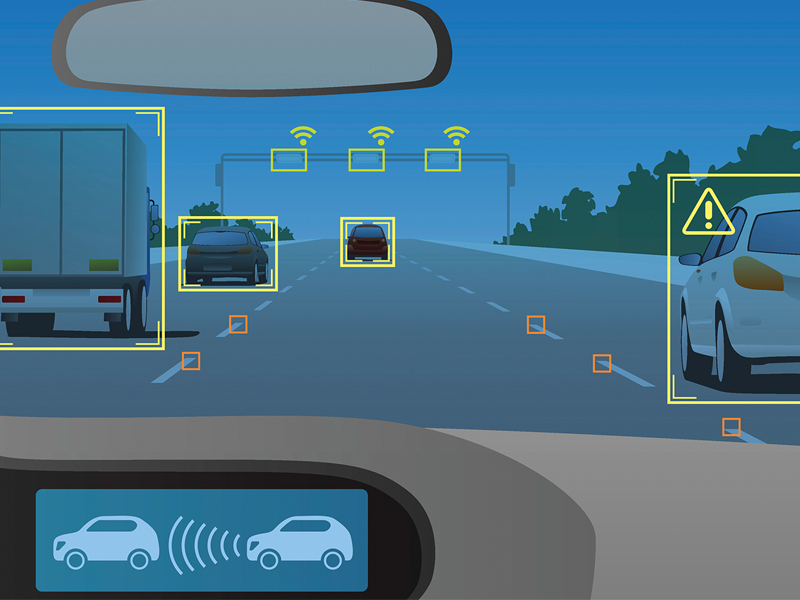

We hear a lot about self-driving cars, but what’s actually in the technology that makes them possible? There are some proprietary systems in the works like AEye’s “iDAR” which uses solid-state lidar, a low-light camera, and artificial intelligence, but lidar and radar are the two systems most commonly used in self-driving car tech. Let’s take a look at some of the most popular systems and weigh the pros and cons as lidar and radar duke it out to become the industry standard in the emerging field of autonomous driving.
First of all, what’s the difference between lidar and radar? Lidar is short for Light Detection And Ranging. It’s a more modern (but still pretty old) version of the tried and true radar which is short for Radio Detection And Ranging. When you know what the two acronyms stand for, the main difference becomes pretty self-explanatory. Radar uses radio waves to detect objects and determine their range, angle, and/or velocity while lidar does basically the same thing, but with pulsed laser light rather than radio waves. Essentially, it is two different technologies that achieve the same goals.
Lidar is the preferred technology of Waymo, one of the heavy-hitters in self-driving cars. Waymo’s lidar systems are designed in-house “so [Waymo] can create the safest, most reliable self-driving system for our vehicles,” in Waymo’s own words. “LiDAR bounces a laser off an object at an extremely high rate—millions of pulses every second—and measures how long the laser takes to reflect off that surface. This generates a precise, three-dimensional image of the object, whether a person, vehicle, aircraft, cloud, or mountain,” says Waymo’s lidar fact sheet. That highlights one of the great things about lidar—its ability to create a three-dimensional image. Waymo’s lidar has become so advanced that it can not only detect pedestrians but figure out what direction they’re facing so a self-driving car can more accurately predict where the pedestrian will walk. This level of accuracy also allows Waymo Pacificas to see hand signals from bicyclists and drive accordingly. That’s the next-best thing to human eyes.
However, there are cost and reliability issues with lidar. Lidar is generally more expensive than radar and lidar has more moving parts which create more room for error. In order to get those advanced, accurate images Waymo needs a lot of moving parts with three different kinds of lidar systems equipped to its vehicles. Radar may not be as fancy or as smart, but it’s affordable, reliable, and has a longer “eyesight,” if you will.
I spoke with Chuck Price, Vice President of Product of autonomous trucking technology company TuSimple, which uses radar, and asked what made its tech different from the competition. “We are a camera/radar fusion technology, we’re not using lidar in our commercial use,” said Price. “We’re trying to hit a commercial price point that is practical and you can’t do that with lidar. Lidar doesn’t have the range or the reliability that we require in large trucks.” I asked for more examples of the advantages of a radar system over lidar and Price told me “there are a lot of advantages. We can see farther, the sensors are less expensive, cameras are solid-state, so they’re reliable in the long term. In trucks, the OEM typically wants to see components last a million miles and you have a better chance of that with a solid-state system than you do with something with rotating parts.”
For commercial use that requires many years and many miles of durability and reliability, cameras and radar are proven, low-cost technologies that make a lot of sense on big trucks. Radar may not have some of the merits of lidar, but radar can see a longer distance than lidar which is very important for trucks that require more time and distance to come to a stop than a passenger car. “[a] great challenge of trucks is their stopping distances are longer [than cars],” said Price. “You need much longer range sensors in order to fully understand the environment and make proper decisions along the highway like when to change lanes.”
If lidar can someday get to the point of affordability and reliability that radar has achieved along with matching its range, then it’s likely lidar will become the industry standard. Until that happens, we’re likely to have a mixed bag in the industry between cheap, reliable, long-range radar and advanced, high-tech, high-detail lidar.